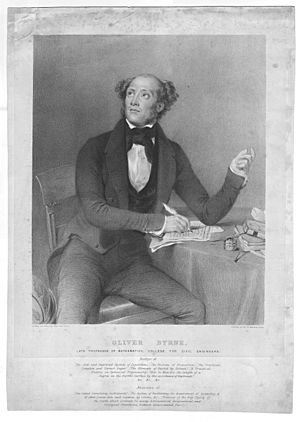Oliver Byrne (mathematician) facts for kids
Quick facts for kids
Oliver Byrne
|
|
|---|---|

Lithograph of Oliver Byrne
|
|
| Born | 31 July 1810 Avoca, County Wicklow, Ireland
|
| Died | 9 December 1880 (aged 70) |
| Known for | His 'coloured' book of Euclid's Elements |
Oliver Byrne (born July 31, 1810 – died December 9, 1880) was a very clever civil engineer and a writer who created many books. He wrote about subjects like mathematics, geometry (the study of shapes), and engineering (how things are built). He is most famous for his unique "colored" book of Euclid's Elements. This book made learning geometry much easier for many people.
Contents
Early Life and Family
Oliver Byrne was born in a beautiful place called the Vale of Avoca, County Wicklow, in Ireland. His parents were Lawrence Oliver Byrne and Mary Byrne. He had a younger brother named John, who even wrote a book with him later on.
We don't know much about Oliver's childhood. He first appeared in Dublin when he was 20, publishing his first book. By the time he was 29, he was helping to support his mother and sisters in Ireland. Later, in England, he became a Professor of Mathematics at the College for Civil Engineers in Putney.
Oliver's Marriage
Oliver Byrne married Eleanor Rugg, who was 12 years younger than him. Eleanor was also very smart! She wrote articles and books about the weather. There's even a special coin made to celebrate one of Oliver Byrne's inventions, called Byneore, that features Eleanor.
Byrne's Famous Euclid Book
Oliver Byrne's most amazing teaching work was a special version of the first six books of Euclid's Elements. Euclid's Elements is a very old and important book about geometry. What made Byrne's version special was that he used colored pictures and symbols instead of just letters to explain each geometric idea.
This book was published in 1847 by William Pickering. Today, people are very interested in this book again. They love its new way of using graphics. It even seems to predict the modern art styles of the Bauhaus and De Stijl movements.
A famous writer about information design, Edward Tufte, has mentioned Byrne's book in his own work. In 2010, a company called Taschen made a new copy of the book so more people could see it. In 2017, a project started to create colored versions of the rest of Euclid's books.
Oliver Byrne called himself a mathematician, a civil engineer, a military engineer, and a mechanical engineer. He also said he was a surveyor for Queen Victoria in the Falkland Islands. However, there is no proof that he ever actually went to the Falkland Islands.
The U.S. Library of Congress has a cool portrait of Oliver Byrne made from steel engraving.
Engineering and Inventions
Oliver Byrne worked on many railroad projects. He also invented several machines and tools. Some of his inventions include:
- The Byrnegraph
- The Gauger's Patent Calculating Instruments
In 1842, Oliver Byrne and Henry William Hull suggested creating a new school. This school would teach math, engineering, classic subjects, and general literature. It was planned for Surrey Villa, near Lambeth Palace.
Byrne also wrote a book against phrenology. Phrenology was a belief that you could tell a person's character from the shape of their skull. Byrne thought this idea was wrong.
Supporting Irish Independence
In 1853, while living in the United States, Oliver Byrne wrote a book called Freedom to Ireland. This book was published in Boston. In it, he talked about the idea of Irish people gaining independence from British rule. He also gave advice on how people could prepare for such a struggle.
Oliver traveled around the United States, giving lessons. He taught people how to use small weapons and how to build simple defenses. He also taught about fighting in streets and fields. Freedom to Ireland was dedicated to the memory of William Byrne, who was a relative. Oliver believed William was a brave leader for his country.
Oliver Byrne supported groups like the United Irishmen and the Irish Home Rule Association. These groups believed that people of different religions, like Protestants and Catholics, could live together peacefully in Ireland. They wanted equality for everyone.
Oliver Byrne's Death
Oliver Byrne passed away when he was 70 years old. He died on December 9, 1880, from a lung illness called bronchial pneumonia. He is buried in Maidstone (Sutton Road) Cemetery in Maidstone, Kent, England.
Images for kids


